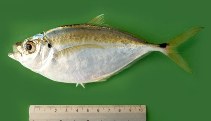| Family: |
Carangidae (Jacks and pompanos), subfamily: Caranginae |
| Max. size: |
30 cm TL (male/unsexed) |
| Environment: |
benthopelagic; brackish; marine |
| Distribution: |
Eastern Pacific: San Pedro, southern California, USA to Peru, including the Gulf of California. |
| Diagnosis: |
Body oval and strongly compressed; snout short and blunt; chest covered with scales; lateral line conspicuously curved anteriorly, with 6 to 14 very weak scutes along the caudal peduncle; lower branch of first gill arch with 9 to 12 gill rakers; body and head blue green; flanks and belly silvery; edge of operculum with very characteristic black stain; dorsal region of caudal also stained black (Ref. 55763). |
| Biology: |
Adults form schools in coastal marine and brackish waters, including lagoons with mangroves (Ref. 9283). Often make a grunting sound when captured (Ref. 9283). Marketed fresh, salted and fried (Ref. 9283). |
| IUCN Red List Status: |
Least Concern (LC); Date assessed: 30 April 2008 Ref. (130435)
|
| Threat to humans: |
harmless |
Source and more info: www.fishbase.org. For personal, classroom, and other internal use only. Not for publication.
